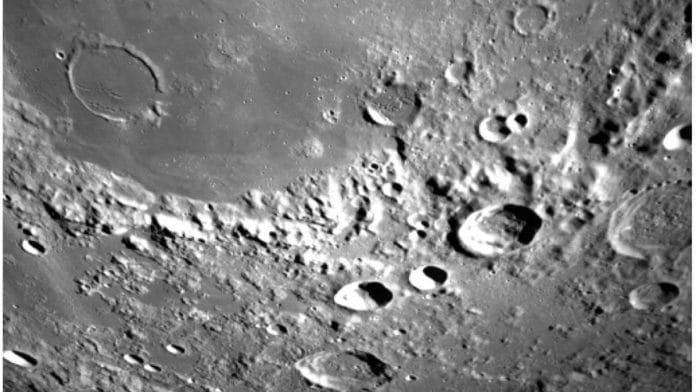Bengaluru: India is gearing up to land a spacecraft on the Moon within 24 hours as part of its Chandrayaan-3 mission. If successful, it will become the fourth country — after the US, Russia and China — to soft-land (or land without significant damage to the vehicle) on the lunar surface.
The Chandrayaan-3 mission, sent to the Moon on 14 July, consists of the Vikram lander, which carries the Pragyan rover.
The spacecraft has already performed two orbit-lowering manoeuvres around the Moon, according to the Indian Space Research Organisation (ISRO), and is now prepared for landing.
The process will start at approximately 5.45 pm IST Wednesday, when Vikram will begin descending from an altitude of 25 km. The entire sequence will take about 15 minutes, after which the lander is expected to soft-land at the lunar south pole around 6.05 pm IST.
The Chandrayaan-3 spacecraft has also established a communication link with the Chandrayaan-2 orbiter, which will be used to relay signals from the lander.
Once on the Moon’s surface, the lander will perform checks and test its payloads. Later, Vikram will deploy a ramp for the Pragyan rover to roll out.
Pragyan can communicate only with Vikram, which in turn will communicate with the Earth directly, and also through the orbiting Chandrayaan-2.
Launched in 2019, Chandrayaan-2 had also carried a lander to the Moon but failed to soft-land it, preventing ISRO from rolling out the previous rover for further exploration of the lunar mission.
Also Read: Communication with space-probe Voyager 2 lost after NASA sends wrong command
What are the payloads?
The Vikram lander carries four payloads — the Radio Anatomy of Moon Bound Hypersensitive Ionosphere and Atmosphere (RAMBHA), which will study the local gases and plasma in the environment and their variations, the Chandra’s Surface Thermophysical Experiment (ChaSTE) will study the Moon’s thermal conductivity and surface temperature, the Instrument for Lunar Seismic Activity (ILSA) for measuring the seismicity around the landing site, and a passive Laser Retroreflector Array (LRA) from NASA that will allow for lunar laser ranging studies.
Pragyan has two payloads: Alpha Particle X-ray Spectrometer (APXS) and Laser Induced Breakdown Spectroscope (LIBS), which will analsye and map the elemental composition of the regolith (lunar soil) and negligible atmosphere in the neighbourhood of the landing site.
Meanwhile, the Chandrayaan-3 propulsion module, which carried the spacecraft from Earth’s orbit to the necessary lunar orbit, will study Earth’s atmosphere using its payload, Spectro-polarimetry of Habitable Planet Earth (SHAPE).
It will orbit the Moon for a few months (or years), performing spectroscopy and polarisation studies on the atmosphere and clouds, to gather biosignatures that can be used to identify habitable exoplanets.
The propulsion module is expected to function for about three months, but carries 150 kg of fuel, which can give it a longer lifespan going into years.
Why the lunar south pole?
Moon’s south pole has been of interest to astronomers for several decades due to the presence of liquid water ice there.
Lunar water offers many advantages, the prime ones being a source of sustenance as well as rocket fuel in the far future.
In this heavily cratered region, there are many craters that are in permanent shadow due to the Sun’s angle owing to the Moon’s axis.
In these places, the surface is undisturbed since it formed millions of years ago. Such regions, known as cold traps, act as planetary fossils, revealing information about the elements present during the formation of the solar system and the Earth-Moon system.
The Vikram lander is currently expected to land between the Manzinus C and the Simpelius N craters.
How long will the mission last?
Chandrayaan-3 is a technology demonstrator mission to show ISRO’s capability to land on the Moon. Because of this, and the cost-efficient nature of the mission, its modules are not built to function for a long time on the lunar surface.
According to ISRO, the Vikram lander and Pragyan rover are expected to function for 14 days. The main reason for this is that one lunar day is equal to 14 Earth days.
Both spacecraft use solar panels, and the lack of Sun for two weeks, coupled with the extreme cold of the lunar night, will likely render them powerless and unusable.
What are landing risks?
In 2019, a software glitch caused the Vikram lander to exceed its course, and a few seconds before landing, the spacecraft crashed about 750 metres from its intended location.
ISRO has now said that it has improved the lander’s software and performed extra tests to ensure a soft landing.
Prior to contact, Chandrayaan-3’s Vikram lander will be moving at less than 2 metres per second in the vertical direction and less than 0.5 metres per second in the horizontal direction, to ensure a safe, slow, and steady touchdown, according to ISRO.
On Sunday, Russia announced that its Luna 25 spacecraft — its first Moon-landing rocket in 47 years — had crashed into the Moon before its landing attempt, scheduled for 21 August. This happened days after its launch.
Luna-25 crashed after it performed a fuel-burn to reach a pre-landing orbit.
On 19 August, communication was lost with the spacecraft. Repeated attempts could not restore communication. A statement from the Russian space agency Roscosmos said that, based on preliminary analysis, it appeared that the manoeuvre had deviated from the necessary parameters, and the spacecraft entered into an “off-design orbit”, which led it to crash on the Moon’s surface.
Where can one watch the landing live?
Live telecast of the landing will be available at multiple places and on TV channels such as Doordarshan and National Geographic. It will also be available on several YouTube streams.
ISRO will also livestream the landing on Facebook and its YouTube channel.
The official telecast will begin at 5.20 pm on 23 August.
(Edited by Nida Fatima Siddiqui)
Also Read: ‘Thanks for the ride,’ Chandrayaan-3’s Vikram lander successfully separates from spacecraft






